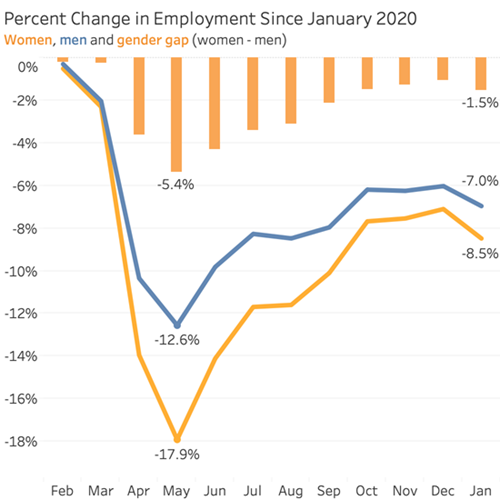Women's Pandemic Job Growth Gap Persists, But with Positive Signs

COVID-19 negatively and disproportionately impacted employment for women, but the job growth gap with men has narrowed and favors women in many jobs.
The COVID-19 global health crisis fundamentally changed the employment landscape. While some employers announced permanent work-from-home arrangements, many employees never could work remotely, and millions remain furloughed or unemployed. As reported earlier in the pandemic, job losses hit women in the workforce harder than men. McKinsey calculated that women's jobs are 1.8 times more vulnerable than men's, with the burden of unpaid childcare playing a critical role.
Much reporting to date on the employment gender gap relies on Bureau of Labor Statistics reporting and doesn't reveal the impact to different jobs – which vary greatly in work performed and pay. ADP DataCloud can provide this insight with anonymized client data on 30 million workers, 1,000,000 organizations, and all industry sectors. The overall gender gap and trend look the same: what was a negligible difference in employment growth for February 2020 (the month before COVID-19 was declared a national emergency) quickly widened. By May 2020, 17.9% fewer women held jobs across all sectors, compared to 12.6% fewer men.

Conditions improved following the CARES Act, Federal Reserve policy interventions, and the sporadic resumption of pre-pandemic activity. While total employment remained down in January 2021, the growth gender gap narrowed to -1.5% for women, a 72% improvement over May.
The gap varies widely, however, among the thousands of different job types that make up employment – registered nurse, carpenter, teacher, software developer, and so on. To see that, let's first look at a graph that sets up the job-level view. We have a single, large circle sized for all employment in our data, centered on the -1.5% average gap and the median annual base pay of $47,000.

Now let's break that circle down into the different jobs within it:

While there are too many jobs to review comprehensively, it's clear many have a positive gender gap for women – and this is true across the range of pay. Let's look more closely at the four highlighted examples, chosen for being highly impacted by the pandemic or having high total employment, job growth, or pay.

- Waitstaff (Highly Impacted) — This high employment job for women was one of the hardest hit by the pandemic, suffering a 42% decline overall as restaurants struggled through shutdowns, capacity restrictions and seasonal challenges to outdoor dining. However, women have retained 6.2% more of their jobs than their male colleagues in this sector.
- Customer service representative ("CSR" - High Employment) — With even higher employment than waitstaff, CSRs also skew female, but the role is better suited for remote work. While there are 4.9% fewer women employed than before the pandemic, that's 55% better than the 10.9% decline in jobs for men.
- Truck driver (High Job Growth) — With consumer spending down in leisure services and up for many goods, truck drivers are in demand, and employment is up 8.4% for this role. Women are pursuing and being hired for these jobs. Starting with a 5.7% share of this highly male workforce, by January 2021 they held 7.3% of these jobs, a 28% increase.
- Engineering manager (High Pay) — This high-paying supervisory role skews heavily male, as many such jobs do. But as organizations focus on increasing leadership diversity, women have gained engineering manager jobs nearly 2x faster than men since January 2020 – and they're ahead in median base pay as well.
The pandemic isn't over, and the challenges women in the workforce face won't end when it does. But the data shows positive signs on which to build.
Related insight
To learn what employers can do to make work more workable for women post-pandemic, read this article by ADP Chief Economist Nela Richardson. She discusses flexibility in sites and hours, transition periods, and skill building, as well as open communication about career implications.



